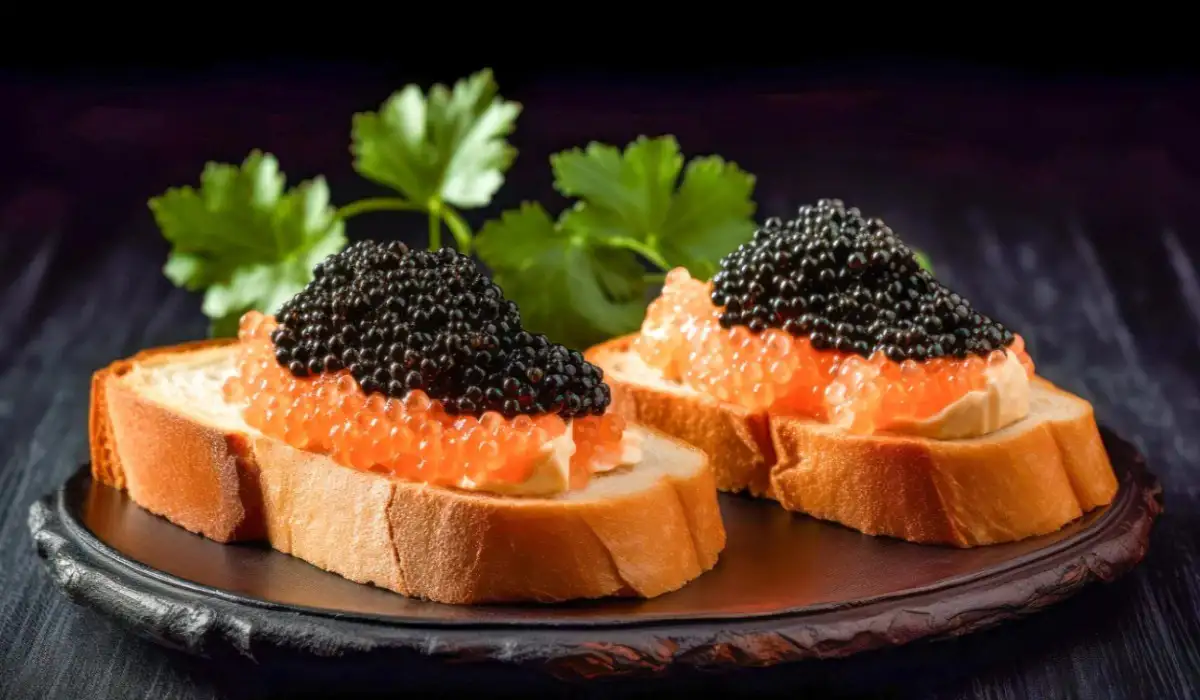July 18th marks a special day in the culinary calendar - National Caviar Day. This day celebrates all there is to enjoy about caviar, a gourmet treat enjoyed across the globe. On this day, we salute the delicate flavor and rich tradition linked with caviar, typically obtained from sturgeon in the Caspian and Black Seas.
National Caviar Day is a moment for culinary experts, gourmet food aficionados, and anyone with an appreciation for fine food to revel in the elegance and charm of this upscale delicacy – maybe even enjoying a spoonful of these lustrous pearls.
History of National Caviar Day
Caviar involves the salt-cured eggs, or roe, specifically from the sturgeon species of fish. This delicacy boasts a rich history, with its existence tracing back to Ancient Greece in the fourth century B.C. The name “caviar” has its roots in the Turkish language, with the word “havyar”. Over the centuries, this treat has become a significant part of the culinary traditions of countries like Russia and Iran, both of which share coastlines with the Caspian Sea, the conventional birthplace of caviar.
The end of the nineteenth century saw a significant drop in the sturgeon population due to overfishing, leading to limitations being imposed on caviar production. As a result, it grew even more highly prized, becoming a symbol of opulence and class. Today, caviar is sourced with a higher regard for sustainability, often from fish farms globally.
Celebrated mainly in the United States, National Caviar Day gives caviar-lovers nationwide a reason to relish their favorite delicacy. The day also advocates public awareness about everything from caviar’s origins to its various types and appropriate serving methods. Additionally, it promotes actions aimed at reducing overfishing and safeguarding sturgeon species.
National Caviar Day Timeline
Caviar Origin
Caviar, salt-cured fish eggs, originated from countries like Russia and Iran. It was considered a delicacy and cherished for its unique, savory flavor.
Caviar in Russian Chronicles
Caviar started to be documented in the Russian Chronicles. During this time, Russian fishermen were known for producing high-quality caviar.
Caviar in America
American sturgeon caviar starts becoming popular in the late 1800s. It was plentiful and cheap, often served as a free bar snack to encourage drinking.
Decline of American Sturgeon
Overfishing leads to a decline in American sturgeon. The availability of American caviar was severely limited, causing prices to rise.
Farmed Caviar Production Begins
Farmed caviar production began due to the decline of sturgeon in the wild. This caused a rise in caviar prices and it became associated with luxury and wealth.
Conservation Efforts
Due to overfishing, conservation efforts are put in place worldwide to protect sturgeon and other species from extinction.
First National Caviar Day
The first National Caviar Day was celebrated on July 18 in the U.S. to recognize the delicacy and increase awareness of sustainable options.
Ideas to Celebrate National Caviar Day
Caviar Tasting Party
Gather your friends and family for a classy caviar tasting party. You can feature different types of caviar, from beluga to sevruga, and pair them with the appropriate drinks like champagne or vodka.
Luxury Caviar Dinner at a High-end Restaurant
Treat yourself to a night of indulgence at a high-end restaurant that serves top-quality caviar. Enjoy the different tastes and textures of this decadent delicacy.
Caviar and Wine Pairing Class
Enroll yourself in a caviar and wine pairing class. Learn what wines complement the various flavors and textures of different caviars to enrich your culinary knowledge.
Caviar History and Culture Education
Learn about the history and cultural significance of caviar. Read related books, watch documentaries or even take an online course to deepen your appreciation of this luxurious food item.
Caviar Shopping Spree
Buy several kinds of caviar from a gourmet food store or online. Compare their tastes, textures, and pairings, and discover your personal favorite.
8 Interesting Facts About Caviar
World’s Most Expensive Caviar
The world's most expensive caviar on record is called 'Almas', produced from the eggs of a rare albino sturgeon between 60-100 years old. It can cost up to $35,000 per kilogram.
Caviar as an Aphrodisiac
Caviar is considered as an aphrodisiac because it is high in zinc, which is said to stimulate libido.
Caviar during the Middle Ages
In the Middle Ages, caviar was prescribed to reduce depression. It's still being studied today for its potential health benefits.
Caviar Classifications
The 'Beluga', 'Ossetra' and 'Sevruga' are the three main types of caviar.
Caviar and Vodka
In Russia, tradition dictates that caviar is best served with vodka, as the alcohol accentuates the flavor of the seafood delicacy.
First Caviar Producing Country
Before the 19th century, Iran was the leading producer of caviar. Today, it’s primarily produced in Russia and China.
Caviar from the New World
The United States once had a thriving caviar industry. In the late 1800s, it was often served for free in saloons to encourage thirst for more beer.
Caviar and Sustainability
Due to overfishing and pollution, sturgeon are now a threatened species. The caviar industry is trying to find more sustainable methods such as farming sturgeon in aquaculture.
National Caviar Day FAQs
Next National Caviar Day Dates
| Year | Date | Day |
|---|---|---|
| 2023 | July 18th | Tuesday |
| 2024 | July 18th | Thursday |
| 2025 | July 18th | Friday |
| 2026 | July 18th | Saturday |
| 2027 | July 18th | Sunday |
| What is the pattern? | Every July 18th | |
National Caviar Day Word Search
- Caviar
- Sturgeon
- Beluga
- Luxury
- Gourmet
- Eggs
